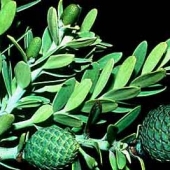Please select root levels for the menu
NZ Plants
Phyllocladus trichomanoides - tanekaha
Celery pine family: Phyllocladaceae
-
Mature foliage consists of phylloclades
L Jensen
View picture -
Phylloclades are in whorls
L Jensen
View picture -
Each phylloclade consists of numerous segments in two rows along a central axis and a terminal bud.
L Jensen
View picture -
Phylloclade, the terminal bud gives rise to a new whorl of compound phylloclades.
L Jensen
View picture -
Growing shoot
L Jensen
View picture -
Scale leaves
L Jensen
View picture -
Growing phylloclade segments
L Jensen
View picture -
Scale leaves and phylloclade segments
L Jensen
View picture -
The phylloclade margin is comprised of numerous branchlet tips protected by curved scales
L Jensen
View picture -
Each branchlet axis (dark green) terminates in a shoot apex with leaf promordia to either side and is covered by a large scale.
L Jensen
View picture -
Seedling with leaves and early phylloclades.
L Jensen
View picture -
Seedling with leaves and enlarged phylloclades
I MacDonald
View picture -
Pollen cones
L Jensen
View picture -
Pollen cone
L Jensen
View picture -
Pollen cone scales detail
L Jensen
View picture -
Young phylloclades with ovule cones.
L Jensen
View picture -
Phylloclade segments with ovule cones
L Jensen
View picture -
Ovule with pollination drop
L Jensen
View picture -
Enlarged ovule with drop receeding into pore (micropyle)
L Jensen
View picture -
Mature cone, fleshy bracts subtending a seed
L Jensen
View picture
Phyllocladus trichomanoides is a pyramidal forest tree with slender spreading branches arising in whorls. Seedling plants have narrow, flattened needle-like leaves. Mature plants have flattened photosynthetic stems (phylloclades) arranged in distinct whorls. Each phylloclade has two rows of linear, often pointed, segments which are not as leathery or as wide as those of P. toatoa. Minute scale-like leaves are formed on segment margins. Small, fleshy ovule cones are formed.
An endemic species found in lowland forest on both North and South Islands.
Vegetative characteristics |
Reproductive characteristics |
|---|---|
Adult plant form: tree up to 30 m |
Pollen and ovule cones: on the same or different trees |
Phylloclade form: broad to linear and pointed |
Pollen cone: in whorls at tips of stems; up to 100 mm long, 80-100 fertile scales |
Phylloclade size: 20-40 mm long x 10-20 mm wide |
Ovule cone: globular, 3-5 mm with 8-12 fertile scales/bracts |
Phylloclade margin: toothed to deeply incised |
Ovule cone position: at margins of phylloclades, or replacing a phylloclade |
Phylloclade arrangement: arranged on either side of whorled stems (rhachides) |
Ovule coverings: a single covering (integument) |
Stem arrangement: in whorls of 3-5 |
Ovule pore: directed upward |
Adult leaves (denticles): scale-like, 1-2.5 mm, on margin of phylloclade segment |
Mature seed cone: each seed develops a white flesh (aril) at the base and becomes enclosed by enlarged sterile bracts that turn reddish or purplish |
Juvenile leaves: singly on stem, narrow-linear (needle-like) up to 15 mm, deciduous |
Stem (receptacle) below seed: stalk not fleshy |




